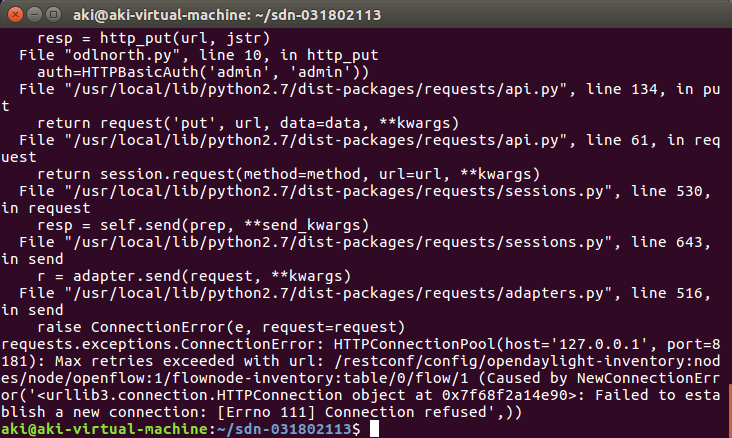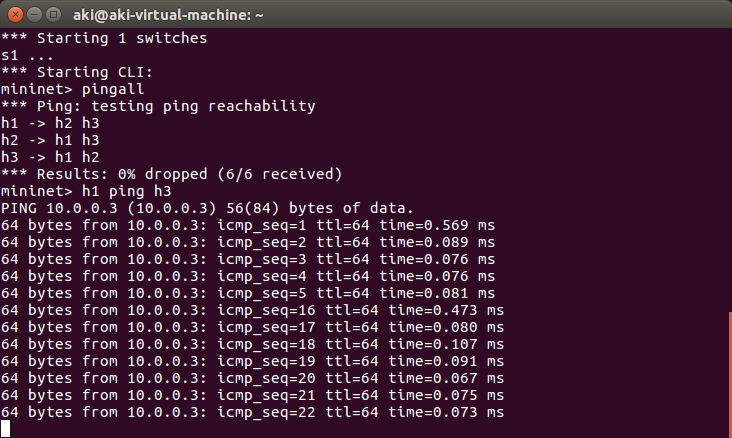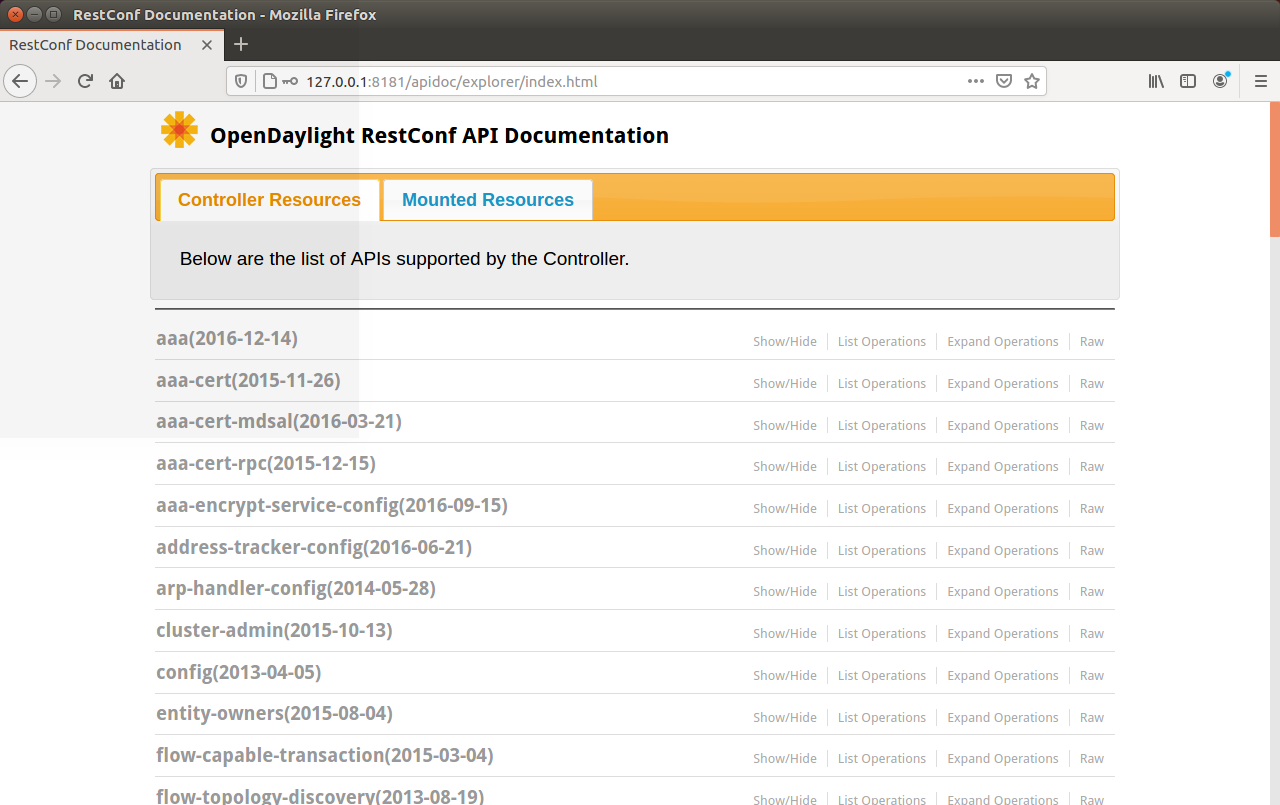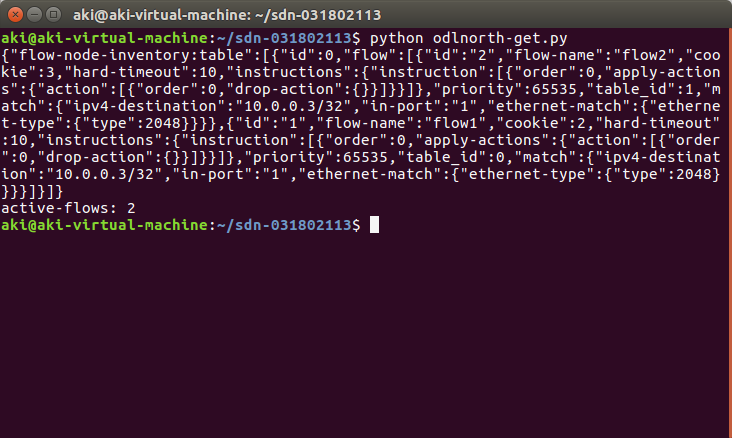一、实验目的
对 Python 调用 OpenDaylight 的 REST API 方法有初步了解。
二、实验任务
本实验需要用另一种方法完成上一个实验相同的功能,即通过 Python 程序调用 OpenDaylight 的北向接口下发关于硬超时的流表,实现拓扑内主机在一定时间内的网络通断。实验拓扑如下:

三、实验步骤
1. 实验环境
安装了 Ubuntu 16.04.7 Desktop AMD64 的虚拟机
2. 实验过程
(1)生成拓扑
$ sudo mn --topo=single,3 --controller=remote,ip=127.0.0.1,port=6633 --switch ovsk,protocols=OpenFlow13
生成拓扑的方法同之前的实验一致。

(2)编写 Python 代码和 JSON 格式的请求内容
$ nano odlnorth.py
#!/usr/bin/python
import requests
from requests.auth import HTTPBasicAuth
def http_put(url, jstr):
url = url
headers = {'Content-Type': 'application/json'}
resp = requests.put(url, jstr, headers=headers,
auth=HTTPBasicAuth('admin', 'admin'))
return resp
if __name__ == "__main__":
url = 'http://127.0.0.1:8181/restconf/config/opendaylight-inventory:nodes/node/openflow:1/flow-node-inventory:table/0/flow/1'
with open('hardtimeout.json') as f:
jstr = f.read()
resp = http_put(url, jstr)
print resp.content
由于是下发流表,因此需要有 http 请求的具体内容,同之前的 Postman 一样, 也是以 JSON 格式来表示。
编辑 hardtimeout.json 文件:
$ nano hardtimeout.json
文件中不包含 http 请求的 url 地址
{
"flow": [
{
"id": "1",
"match": {
"in-port": "1",
"ethernet-match": {
"ethernet-type": {
"type": "0x0800"
}
},
"ipv4-destination": "10.0.0.3/32"
},
"instructions": {
"instruction": [
{
"order": "0",
"apply-actions": {
"action": [
{
"order": "0",
"drop-action": {}
}
]
}
}
]
},
"flow-name": "flow1",
"priority": "65535",
"hard-timeout": "10",
"cookie": "2",
"table_id": "0"
}
]
}
(3)运行 Python 代码,完成流表下发
$ python odlnorth.py
问题:报错:ImportError: No module named requests。
解决:可尝试如下方法。
$ sudo apt-get install python-pip //如果 pip 没装的话需要运行
$ sudo pip install requests

问题:报错 requests.exceptions.ConnectionError。
解决:原因可能是未开启 OpenDaylight 控制器。到相应安装目录执行 ./karaf 打开即可。

问题:报错 {"errors":{"error":[{"error-type":"protocol","error-tag":"unknown-element","error-message":""flownode-inventory" module does not exist."}]}} 和 IndentationError: expected an indented block。
解决:注意复制代码时缩进和连接符是否正确。
结果验证方法同实验 6。
先在 Mininet CLI 中运行 h1 ping h3,再运行 odlnorth.py。

h1 ping h3 有 10 秒时间是中断的,结果符合预期。
* 更多 OpenDaylight 的 REST API 文档可以在下面的地址中查找:
http://127.0.0.1:8181/apidoc/explorer/index.html

(4)获取活动流表数目
GitHub 地址:https://github.com/yellow-akihiro/SDN-lab7
#!/usr/bin/python
import json
import requests
from requests.auth import HTTPBasicAuth
def http_get(url):
url = url
headers = {'Content-Type': 'application/json'}
resp = requests.get(url, headers=headers,
auth=HTTPBasicAuth('admin', 'admin'))
return resp
if __name__ == "__main__":
url = 'http://127.0.0.1:8181/restconf/config/opendaylight-inventory:nodes/node/openflow:1/flow-node-inventory:table/0/'
resp = http_get(url)
data = json.loads(resp.content)
if data.get("errors"):
print "active-flow(s): 0"
else:
print resp.content
print "active-flow(s): " + str(len(data["flow-node-inventory:table"][0]["flow"]))
上述实验测试结果:

两份流表测试结果:

四、实验要求
(已在实验步骤中体现)
- 根据实验步骤复现上述实验,指导书仅提供参考方法,如果你对 Python 比较熟悉,且有其他方法,欢迎使用。
- 利用 Python 程序获取本实验拓扑中的交换机 s1 中活动的流表数目 active-flows。(选做题,不做强制要求)
- 在博客园发表一篇博客,记录主要步骤,如果完成了选做题,请在博客标题上标注,并提交程序到 GitHub,展示运行结果。
五、实验总结
本次实验使用 Python 脚本调用 OpenDaylight 控制器的 REST API 完成了与上次实验类似的任务。中间遇到的问题比较多,尤其是从 PDF 文件中复制代码的时候缩进和部分符号都会出问题。还有 OpenDaylight 要记得先打开。解决方案在实验步骤中都有体现。